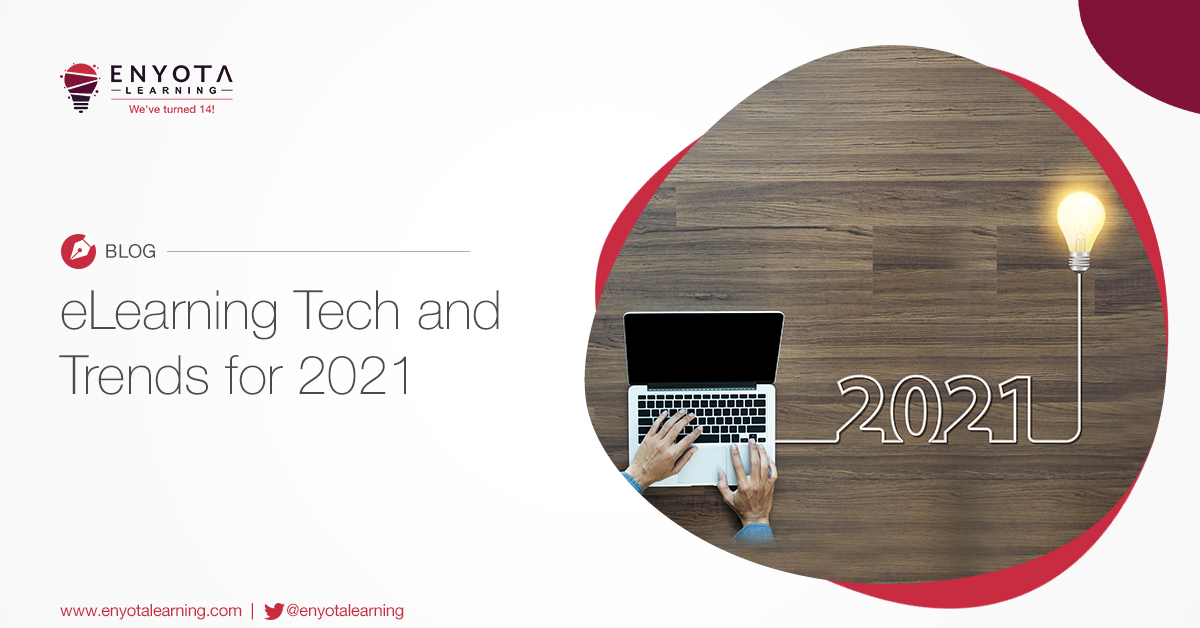2020 was an eventful year for eLearning. If anything, it cemented the fact that trainers and development experts must consider eLearning as the way ahead for the entire training and development industry. But that doesn’t mean in-person training is out of the question.
We think some form of blended learning must definitely be thrown into the mix. So, when rephrasing, we think blending eLearning and some form of traditional methods of training is the way forward. So, consider blended learning as a definite part of the mix.
However, there are a few rules that the industry, implementers, and users can definitely consider adopting when setting the pace for eLearning trends for 2021.
Heads up. The two rules for eLearning in 2021 are to keep eLearning budgets and deployment time in mind. The reason? Situations change fast and the need to get the right training out on time is very important. And what follows? When rapid, unwelcomed changes affect businesses, it affects the budgets for everything, including the budgets for training departments and training activities.
So, time and money, the two resources most dear to eLearning, together with blended learning forms the backbone for this one. Keeping that in mind…
Here are the eLearning trends for 2021 with the latest and best training technologies
Homegrown Subject Matter Experts and Content
Minimizing the costs of eLearning is possible when the subject matters experts, ‘the people who frame the basic training content for your training program,’ are from within your organization. This trend looks like a good example of early-stage social learning becoming a common practice in eLearning. The eventualities of using ‘user generated data and content’ which stem from learning experiences of employees is very promising.
We’d say there is no better subject matter expert than one who practices their craft every day. These experts can share their best and worst experiences which form the basis for the training content. These experts can outline the best practices to follow and do things right. Moreover, their success stories can be used as guidelines to success.
There is definite gold hidden in this concept for those who take it head-on and it shows great potential for implementers.
The two challenges faced by L&D when identifying internal SMEs are:
- Looking for candidates with strong communications skills. After all, their experience will form the backbone for the training content, and for that communication is important.
- Looking for candidates with true and complete knowledge in their domain. A preliminary test to identify the best candidates is important. Only a test will reveal the best candidate for the role.
Video Conferencing and VILT – Video Content
No surprises here. The world is operating in a remote mode and people are in touch via video conferencing applications. If meetings and briefs work well with members attending from remote locations, there is no reason why eLearning will not work either. In fact, VILT is one of those sticky eLearning trends of 2020 which people have adopted with enthusiasm. Moreover, there is no logical reason why organizations should not continue to practice it in 2021.
Obviously, blending the practice is the secret to making the right training sauce in 2021. VILT sessions can sometimes work in an offline mode as well. These bits are purely to humanize training because some people may feel alienated by remote working and now remote training as well.
And we have also said this before – there is no reason why traditional training cannot be a part of the training pie. It is about understanding your learners and then deciding what combinations works best and their right quantities.
One thing is for sure, the industry and its practitioners need to take training from home in the same stride as they did with working from home.
Trainers doing this for the first time will definitely feel out of place, but it is a part of the learning and development journey for them as well!
Slide-Based eLearning and Rapid Development – Just-in-Time Training
Coming back to implementing a trend that will not only save budgets but reinstate the confidence of people in eLearning is rapid eLearning development.
Training is most effective when the need to learn is in the present.
Just take the recent pandemic as a textbook example to deploy just-in-time training. Employees moved out of the office and into remote work environments within a span of days. While some coped with this change, others felt uncomfortable in this new setting. Managers needed to manage a remote workforce. Sales teams had to adopt a new way of selling. Some organization could handle this change while others struggled.
It was in moments such as these that rapid eLearning deployment is most needed. The need for some format of training to help people normalize while also setting new KPIs for employees to follow became apparent.
Authoring tools can play a big role in developing such compact training. Especially ones that focus on rapid eLearning development. These tools support simple slide-based eLearning development with varying levels of functionalities that can be added as layers to the eLearning course.
We believe that rapid eLearning development and training will eventually become the new normal.
However, developing this training content is not always simple, even though the idea is to simplify the training development process. In such cases, it is best to reach out to professional eLearning development companies and seek their assistance.
Trimmed Content – Microlearning
Close on the heels of rapid eLearning development is microlearning.
People believe the term microlearning stands for multiple short 5 to 10-minute eLearning modules wrapped together into one eLearning program. Yes, that is true for most parts, but true microlearning stands for short or trimmed content.
Basically, the ability to take an eLearning course and cut out the content that adds the fluff to it. Then break the important bits of content into micro-formats and upload all these formats in a logical order.
Microlearning aims to cut out the unneeded content that makes a course more time consuming than it should be. This content is then broken into short eLearning segments that are patched together to form an eLearning course.
The real trick to master when talking about microlearning courses is to identify the content that can be left out versus the content that is needed.
The idea of microlearning is to quickly deploy training that learners consume with only the most needed information. The rest is fluff.
A quick addition to the growing benefits of microlearning is its ability to serve mobile users and their mobile devices well.
Microlearning has made it to our list for the third consecutive year, and for good reason. All major industry players like LinkedIn Learning and Udemy only publish content in microlearning formats, cementing its credibility among all. As a result, we think it deserves a spot on the eLearning trends for 2021 as well.
Converting Flash to HTML
2020 was the year that Flash made an exit. This exit turned years of Flash-built courses into legacy eLearning courses in need of immediate updating. Security and stability are important for any organization working with IT products and Adobe’s decision to end all support for update patches, security, and cross-device compatibility is a clear indication for organizations to either stop using their existing Flash courses or revamp their legacy content.
Organizations looking to convert their courses have the option of using rapid eLearning development tools or reaching out to custom eLearning developers who will use their existing Flash-based courses to build new HTML courses.
These HTML courses are cross-browser compatible, supported by regular updates, and far more stable than the outdated Flash courses.
Less than 3% websites today use Flash and browsers consider these websites as dangerous to access. Which leads us to the question that would organizations still consider Flash safe to use, even if on their internal servers?
Machine Learning Enabled Content Suggestions – Most Promising eLearning Trend for 2021
Finally, with 2021 around the corner, we cannot resist but talk about the machines taking over. Well, maybe not the world, but at least your learning and development menu. We have seen that YouTube and Netflix style recommendations work well with the masses.
Algorithms predict the next show you may be interested in watching based on global user metrics combined with your personal preferences. It may even consider your gender and age, but that is for more advanced predictions.
However, training and development can immediately benefit form ML predictions by recommending the best eLearning course to take up and pursue. This is one learning trend that will only increase with time as technology advances.
ML algorithms are already responsible for the media, news, and information we consume on a daily basis. Just look at Facebook, LinkedIn, and the Google search engine. These major platforms for ‘information consumption’ use ML to predict new content and refresh user’s feeds with familiar content.
We can see such technology being worked upon and implemented into learning management systems already. Some vendors are marketing these intuitive learning management systems as brand new platforms altogether. But that does not take anything away from our trusty LMS. We think ML predictions are an easy addition to any LMS, as long as the ML prediction algorithm is ready and working. This is also one of the most promising eLearning trends for 2021.
Welcoming the eLearning trends for 2021
2021 is about the year of saving costs of time, efforts, and money. It is about deploying personalized yet economical eLearning solutions within a short span of time. The focus is more on training people in the most economical way possible over training people in the best way that money can buy.
We are here to help with your custom eLearning development needs. All we need is the content, you could even use your own user generated content that we convert into eLearning for you. Another option is to convert your traditional training content into microformats. We can start by chopping the information that is not needed and increasing the interest in bits that are important.
To know more about the eLearning trends for 2021 or get started, reach us at contact@enyotalearning.com or click heref to know more!





